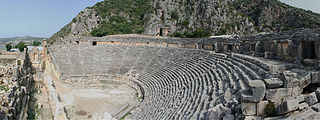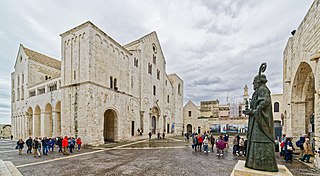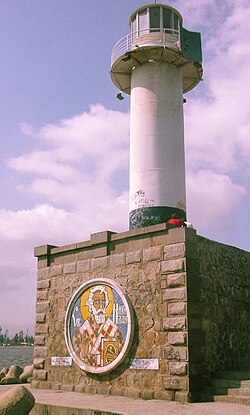
Myra was a city in Lycia. The city was probably founded by Lycian on the river Myros, in the fertile alluvial plain between, the Massikytos range and the Aegean Sea. By the 3rd century BC the city was Hellinized. Following the wars of the diadochi the area came under the loose control of the Ptolemies, the Seleucids, and finally the Romans.

Saint Nicholas of Myra, also known as Nicholas of Bari, was an early Christian bishop of Greek descent from the maritime city of Patara in Anatolia during the time of the Roman Empire. Because of the many miracles attributed to his intercession, he is also known as Nicholas the Wonderworker. Saint Nicholas is the patron saint of sailors, merchants, archers, repentant thieves, children, brewers, pawnbrokers, toymakers, unmarried people, and students in various cities and countries around Europe. His reputation evolved among the pious, as was common for early Christian saints, and his legendary habit of secret gift-giving gave rise to the folklore of Santa Claus through Sinterklaas.

Nicholas is a male name, the Anglophone version of an ancient Greek name in use since antiquity, and cognate with the modern Greek Νικόλαος, Nikolaos. It originally derived from a combination of two Greek words meaning 'victory' and 'people'. In turn, the name means "victory of the people."

Saint Nicholas Day, also called the "Feast of Saint Nicholas", observed on 6 December in Western Christian countries, and on 19 December in Eastern Christian countries using the old church Calendar, is the feast day of Saint Nicholas of Myra; it falls within the season of Advent. It is celebrated as a Christian festival with particular regard to Saint Nicholas' reputation as a bringer of gifts, as well as through the attendance of church services.

Spyridon, also Spyridon of Tremithus is a saint honoured in both the Eastern and Western Christian traditions.

Demre is a municipality and district of Antalya Province, Turkey. Its area is 329 km2, and its population is 27,691 (2022). It was named after the river Demre.

The Turkish Riviera, also known popularly as the Turquoise Coast, is an area of southwest Turkey encompassing the provinces of Antalya and Muğla, and to a lesser extent Aydın, southern İzmir and western Mersin. The combination of a favorable climate, warm sea, mountainous scenery, fine beaches along more than a 1,000 km (620 mi) of shoreline along the Mediterranean and Aegean waters, and abundant natural and archaeological points of interest makes this stretch of Turkey's coastline a popular national and international tourist destination.

The Pontifical Basilica of Saint Nicholas is a church in Bari, southern Italy, that holds wide religious significance throughout Europe and the Christian world. The basilica is an important pilgrimage destination both for Roman Catholics and Orthodox Christians.

Santa Claus is a legendary figure originating in Western Christian culture who is said to bring gifts during the late evening and overnight hours on Christmas Eve. He is said to accomplish this with the aid of Christmas elves, who make the toys in his workshop, and with the aid of flying reindeer who pull his sleigh through the air.

In Christianity, the translation of relics is the ceremonial removal of holy objects from one place to another. Usually only the movement of the remains of a saint's body would be treated so formally, with secondary relics such as items of clothing treated with less ceremony. Translations could be accompanied by many acts, including all-night vigils and processions, often involving entire communities.

San Nicolò al Lido refers to both the San Nicolò Church and most importantly to its annexed Monastery of San Nicolò located in Venice, northern Italy. The two Catholic institutions are located in the northern part of the Lido di Venezia and house the relics of Saint Nicholas, patron of sailors. From this church, the traditional thanksgiving Mass of the Sposalizio del Mare is celebrated. The complex houses monks of the Franciscan order.

The Oil of Saints, also known as the Manna of the Saints, is "an aromatic liquid with healing properties" or "holy water " which "is said to have flowed, or still flows, from the relics or burial places" of certain Christian saints, who are known as myroblytes while the exudation itself is referred to as myroblysia or myroblytism. In the Eastern Orthodox Church, some icons are also believed to release such oil.
The following cathedrals, churches and chapels are dedicated to Saint Nicholas:

Saint Donatus of Euroea was a Greek saint, who is revered in both by both Eastern Orthodox and Roman Catholics, mostly in Albania and Greece.

St. Nicholas Church is an ancient East Roman basilica church in the ancient city of Myra, now a museum located in modern Demre, Antalya Province, Turkey. It was built above the burial place of St Nicholas, a 4th-century Christian bishop of Myra, an important religious figure for Eastern Orthodox Christians and Roman Catholics and the historical inspiration for Santa Claus. Its use dated from its 6th century construction for the state church of the Roman Empire by Justinian the Great. The basilica is on UNESCO's tentative list to become a World Heritage Site.

Gemiler Island is an island located off the coast of Turkey near the city of Fethiye. On the island are the remains of several churches built between the fourth and sixth centuries AD, along with a variety of associated buildings. Archaeologists believe it was the location of the original tomb of Saint Nicholas. The original Turkish name is Gemile from the Greek word καμήλα (kamila) meaning camel, so called because of its geographical shape.

The Translation of the Relics of Saint Nicholas from Myra to Bari is a religious and folk holiday among the East Slavs and, to a lesser extent, the South Slavs and Eastern Romance peoples. It is celebrated on May 9 each year. For Old (Julian) Calendar churches, May 9 falls on May 22 of the New (Gregorian) Calendar. The feast commemorates the translation (movement) of the relics of Saint Nicholas from Myra to Bari, on the Italian Peninsula. To this day, the relics remain at the Basilica of Saint Nicholas.

St Nicholas of Myra is a Grade I listed parish church in South Ockendon, Essex, England, 20 miles east of London and 8 miles south-east of Romford. The building has been under the National Heritage List for England since February 8, 1960. It stands on the south side of the green in the middle of the village as it has done for 860 years.

Christmas traditions include a variety of customs, religious practices, rituals, and folklore associated with the celebration of Christmas. Many of these traditions vary by country or region, while others are practiced virtually identically worldwide.

Saint Mark's relics, the remains of Mark the Evangelist, are held in St Mark's Basilica in Venice, Italy.


















